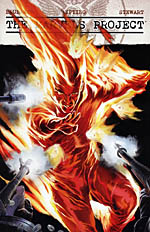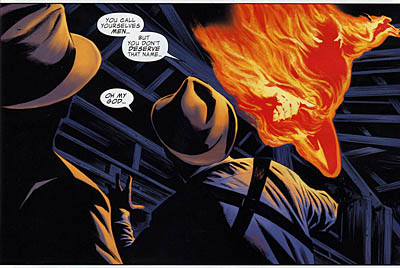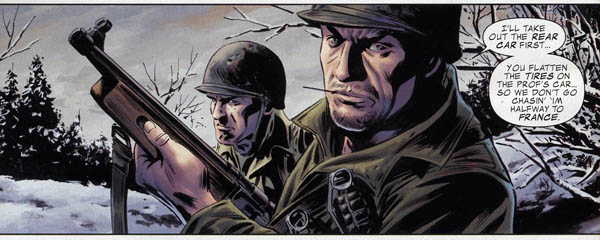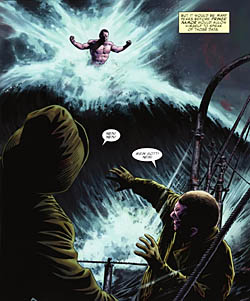 Written by Ed Brubaker
Written by Ed Brubaker
Art by Steve Epting
32 pages, color
Published by Marvel
I picked up The Marvels Project #1-2 without knowing a single thing about the comic, save its creative team. Ed Brubaker and Steve Epting’s work on Captain America was enough of a selling point for me that a new collaboration by the pair seemed like a must-buy item. What I found was a story set in the late ’30s, as America was not yet plunged into World War II and the original Human Torch was being created. As someone whose main exposure to Marvel comics set in that era is Marvels #1, though? I’m utterly enthralled.
Brubaker brings readers quickly up to speed for this time period; it certainly helps that there isn’t a huge difference between the Marvel Universe of 1939 and our own, of course. It’s the dawn of the superhuman, with the invention of the Human Torch android, the early encounters between surface and Atlantean civilizations, and the first caped heroes making their debuts. Once Brubaker has that out of the way, though, he leaps into his story with great aplomb.  Scientists being rescued from Axis Germany, an artificial life form trying to discover its own humanity, and an ordinary human trying to rise above the others to help bring about justice… it’s a lot of compelling stories all making their debuts. I think Brubaker makes it succeed in part because none of these stories are really about super-powers, but about people and their humanity. Our main character may dress up like a modern hero, but he’s armed with nothing but knowledge and a drive to make things right. So while his methods might seem a little strange to the average person on the street, his motives are easy to understand and empathize with.
Scientists being rescued from Axis Germany, an artificial life form trying to discover its own humanity, and an ordinary human trying to rise above the others to help bring about justice… it’s a lot of compelling stories all making their debuts. I think Brubaker makes it succeed in part because none of these stories are really about super-powers, but about people and their humanity. Our main character may dress up like a modern hero, but he’s armed with nothing but knowledge and a drive to make things right. So while his methods might seem a little strange to the average person on the street, his motives are easy to understand and empathize with.
Even the couple of characters at this point who are superhuman still have easy hooks for a reader to feel for. Namor might be an Atlantean, but his avenging the deaths of his people is a simple, easy motive to understand, and Brubaker writes a sufficiently dramatic scene with which Namor can burst onto the scene. The Human Torch goes from a prisoner to someone questing for humanity, a classic theme that everyone’s encountered at some point or another. His story is still just beginning in these first two issues, but Brubaker helps us get into the Torch’s head thanks to his choice of narrator. Dr. Thomas Halloway’s writings are easy-going and non-pretentious, while still delving into the minds and motivations of his subjects.

 Epting’s art is as handsome as I remembered it. Watching Epting’s star rise over the past decade has been a real joy, as he’s continually strengthened and refined his art. Part of what I think makes him such a good collaborator with Brubaker is how strong Epting is at drawing average, ordinary people and still making them look distinct. There’s a scene at the end of the second issue where a character walks into a police station in ordinary clothes, and even though up until now we’ve only caught him in brief glimpses in a special jumpsuit, he’s instantly recognizable. It sounds strange to praise someone for being able to draw such distinct faces, but in a superhero comic that can be rare. From army privates to people on the street, everyone looks unique and individual, with a smooth, lush look for the entire scene.
Epting’s art is as handsome as I remembered it. Watching Epting’s star rise over the past decade has been a real joy, as he’s continually strengthened and refined his art. Part of what I think makes him such a good collaborator with Brubaker is how strong Epting is at drawing average, ordinary people and still making them look distinct. There’s a scene at the end of the second issue where a character walks into a police station in ordinary clothes, and even though up until now we’ve only caught him in brief glimpses in a special jumpsuit, he’s instantly recognizable. It sounds strange to praise someone for being able to draw such distinct faces, but in a superhero comic that can be rare. From army privates to people on the street, everyone looks unique and individual, with a smooth, lush look for the entire scene.
Mind you, Epting can also handle action as well. When Namor attacks the Germans in the first issue, the crash of the wave over the bow of the ship looks like it’s in motion, the water’s fury raging onto the page. I love that sense of motion that Epting brings to his art. When the Human Torch flies in the second issue, he seems to glide effortlessly across the panel. At the same time, though, Epting makes him look like a real cross between a human and a being of fire; for the first time, I think it’s understandable why people would be afraid of the Human Torch and demand that he be locked up. Here, it’s not just a man whose skin is on fire, but a synthesis of person and elemental fury.
The Marvels Project has started with two thoroughly enjoyable issues, with six more still to come. As part of Marvel’s celebration of their 70th anniversary, this is a lovely project, celebrating those early World War II characters and situations. Even without that anniversary, though, it’s a comic that plays to both Brubaker and Epting’s strengths. This is the kind of comic that makes people think twice about genres that they might have dismissed before. Brubaker and Epting have created a comic to make an entire company proud. Highly recommended.
